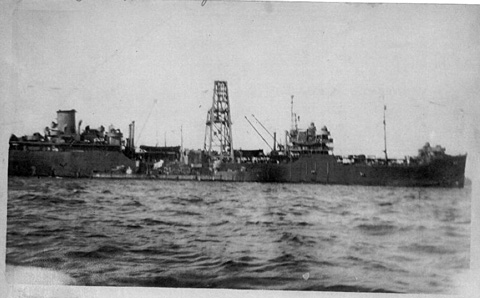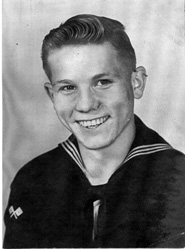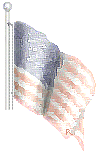Verle “Stash” Alfred Jensen was born 2 April 1927, in Norfolk, Nebraska. His parents were Alfred “Ollie” Nicolaus Bernhard and Christian Andona Henrietta (Klatt) Jensen.
I came to Sioux City at the age of 2 with my mother, two sisters, Louise, Dorothy, and brother, Lyle. My parents divorced in 1929. I grew up in Sioux City and attended schools there.
The “first time” I enlisted was in 1943. I was 16 then. I was living with my sister and her family on Main Street between 8th and 9th. When school started in the fall, I decided to join the Navy instead of going back to school. Basic training was at the Great Lakes Training Center in Illinois then on to Los Angeles and the troop transport, Sheridan, as a passenger and I went to Hawaii. I was assigned to the Helm which was a destroyer. I was on the ship for seven weeks, 1 February through three weeks in March when the Executive Officer called me into his quarters and asked me, “Sailor, how old are you? And before you answer, I already know how old you are!” He read me the riot act and scared me. Back to California I went and they let me go and I was on my own to get back to Sioux City.
Just as soon as I turned 17 on 2 April 1933, I enlisted again and left 3 April for Des Moines by bus for 304 days and then on to Farragut, Idaho, for basic training. The boot camp was nine weeks long then. Everyone thought I was so smart--little did they know that I had been through this before! I went to Signalman School and there I met my buddy, Ken Lathrop. When I got out, I went to Portland, Oregon, where I saw some of my family before shipping out. I was to report to Treasure Island so I boarded a train, the Oregonian, and rode down to San Francisco. They gave me a little ticket stub and I didn’t know what it was for so I threw it away. When I arrived in Oakland, they asked for the ticket stub to get on the ferry. I explained that I had thrown it away and they said, “Just get on anyway”. After getting off the ferry, I was walking up and down Market Street, trying to find out how I could get to Treasure Island. I was to report in by midnight. I took the A train and got to the barracks. There were three barracks in all, with a 10 ft. chain link fence around them. There was a guard at the gate. The Shore Patrol directed me to Door 465. I handed him my papers and he said to me, “Pretty rough, huh?” and he opened the gate. There was another Chief and he told me to find a bunk. In the morning we had chow. This went on for 3 to 4 days until I found out that these ‘barracks’ were for ‘survivors of sunken ships’. I was in there for six weeks. It was just a miracle that my buddy, Ken, was walking down the street outside of these survivors barracks that I was in, and I hollered at him and there was a chain link fence around and he came over and he asked me what the hell I had done to get in there. I told him. Ken told me I was supposed to be on the troop transport, Oneida, but was listed as AWOL. He told me I was up for a general court-martial. After explaining my situation to the officer, they let me go. Anyway, after I got out and I got assigned to a ship, it was a ship that Ken was on!
When I left Signalman School, all my gear was shipped to San Francisco. All the sea bags were in a warehouse. There were thousands and I had to find mine. I was then assigned to the USS Pasig-AW3, which was a tanker. It had a company of 400 men and was attached to the 3rd and 5th fleet. The Pasig made fresh water from sea water for landing craft like LST, LCI and so forth. Thank God the Japanese did not realize that they could have crippled the American fleet by destroying our fresh water supply. When we were out to sea, the one thing I remember was how dark it always
was. We’d be sitting on deck at night without any lights. Our cubicles had lights but none were allowed outside. I liked the Navy and would have stayed in but my buddy, Ken, said he wanted to go back home after war so I decided to do the same. After the war, we went to Kobe, Japan, and we were put on the Japanese battleship, Nagato, as communication personnel as the Nagato was being towed by sea going tugboat, Wahoo, to the Bikini Atoll in the Marshall Islands. Our ship also escorted the Japanese cruiser, Sakawa, to the Bikini Atoll for the atom bomb testing. Then we sailed to Eniwetok that was our home base.
As a pastime aboard ship, bets were made on the time they would drop anchor. One of my shipmates had a diamond ring that he put in the betting pool. I won the ring and still wear it today.
The Navy operated on a point system. If you had 41 1⁄2 points, it was enough to put in for a discharge. Ships were coming through all the time. If you got your papers ready and signed, you could get on a ship headed back to the States – if they had room. Ken decided to go home. We were going back together. Ken got off the ship. He had heard that there was room for 105 men on a carrier. While he was gone, our orders came through. I got the message to Ken and he thought I was kidding. He then found out that all the spaces on the carrier were already taken. He couldn’t get back on our ship before we sailed and stayed on the island for three more months before he got a ship to come back to the States. So I headed home and 40 years later we saw each other again, Ken told me that he watched the ship until it was out of sight.
I arrived in Astoria, Oregon, and took the train to Minneapolis, Minnesota, where I was discharged on 26 June 1946. I rode a bus back to Sioux City, standing all the way as there were no seats available.
In 1947, I began to work for the Old Home Bakery that was located on Pearl Street in those days. Pay was 69 cents per hour. On 18 October 1947, I married a Sioux City girl, Marilyn Joyce Perrin, in Elk Point, South Dakota. We have two children, Ricki Simmons, of Pensacola, Florida, and a son, Scott, of Mill Creek, Washington. We have five grandchildren, B.J. Simmons who is currently serving in the U.S. Navy; Paige Simmons, a college student in St. Petersburg, Florida; twin grandsons in college in Washington, Dough and Brad Jensen; and a granddaughter, Kali Jensen, a senior in high school.
I retired from the bakery after 40 years of employment. I enjoy gardening in my spare time. After 40 years, Ken looked me up and when he knocked at my door and I saw him for the first time since the war, tears filled our eyes. On several occasions, we spent time talking about the old days. Ken passed away a few years ago in Des Moines, Iowa.
I spent time in the Philippines, the Marshall Island, Eniwetok, Iwo Jima and Okinawa. I was awarded the Asiatic Pacific Defense Ribbon, the American Defense Ribbon, the Philippine Defense Ribbon, 2nd Battle of Philippine Ribbon, North Pacific Defense Ribbon and the Unit Citation Ribbon.
Submitted by Verle “Stash” Jensen.

![]()

